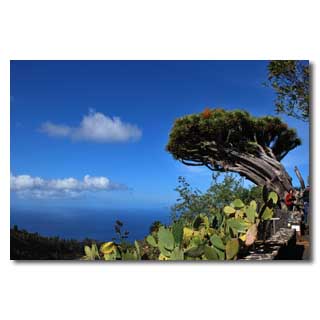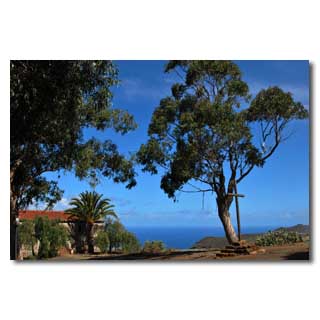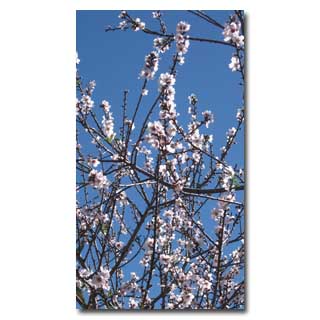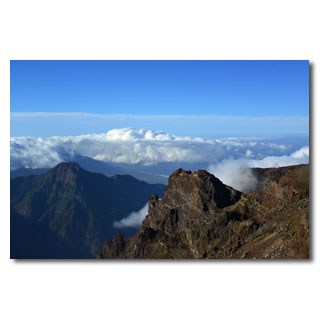Puntagorda - popular village in the northwest
With around 2000 inhabitants Puntagorda is one of the smaller but particularly charming communities of La Palma. The climate is dry and sunny in summer, in winter the north-east trade winds give the village heavy precipitation from time to time, which makes the gardens and fields very fertile. Over the past decades, organic vegetable growing has become established - the farmers' market held on Saturday afternoons and Sunday mornings has become a magnet for locals and guests alike.
Originally, the population lived mainly from almond cultivation, and thousands of almond trees still immerse the surrounding area in picturesque pink between the end of January and the end of March.
The numerous Portuguese settlers made San Mauro their patron saint in the 16th century and gave its name to the first settlement in the Puntagorda area. In honour of him they began in 1571 with the construction of a large, single-nave church in Canarian style, the 'Iglesia de San Mauro Abad'. It has been reconstructed several times over the centuries, has neoclassical and baroque style elements and still serves today as a worth seeing and listening procession which takes place in the middle of January as well as a big fiesta with musical and culinary highlights in August.
The old and the new 'harbour', in former times actually the only possibility to visit the place, are today popular weekend and summer destinations for the locals. Bathing is possible in summer, in winter only in very calm weather.
The southern entrance to the village is marked by a 600-year-old dragon tree, to which a small park with picnic facilities was dedicated.

The old dragon tree of Puntagorda …

... landmark of the community.

Its seeds are popular souvenirs for your own cultivation on the windowsill.

The dragon tree is in fact a perennial.

Dragon tree roofed view…

... to a wild and romantic landscape.

The church of the patron saint San Mauro Abad…

.... with baroque bell holder …

... and the best place for a happy fiesta.

false pepper trees provide cool shade…

... and lend romantic flair.

The 'old port', formerly the only access to the community.

Huge, shady cave

As in many places, the…

… Basaltsäulen mit ihrer stark ausgeprägten ... basalt columns with their highly pronounced crystalline structure from the enormous pressure that weighed on them at great depths for millions of years before a volcanic eruption brought them to daylight.

A soft play of colours in an archaic landscape.

Sukkuleen of the arid zone between 0 and 200 meters above sea level…

... and gnarled Canary pines at altitudes between 1000 and 1900 m characterize the extreme locations of the municipality…

... while the place itself is dominated by almonds.

Roque de Los Muchachos
The 'Roque de los Muchachos' at 2.426 m is the highest elevation of La Palma and hosts the most important international observatory of the northern hemisphere. Here is a real high mountain climate, in winter the 'Roque', as the locals call it, is often covered with a snow or ice cap. The observatory is the cause of the only light protection law in the world that exists on La Palma and because of which we are protected from neon or laser advertising. On the Roque you will not only find what is currently (2013) the world's largest reflector telescope with a diameter of 10,40 m; it is also the starting point for many hiking trails through impressive rock formations and the most diverse climatic zones. From the roof of the island you can usually see the neighbouring islands of Tenerife (with Spain's highest mountain, the Teide), as well as La Gomera and El Hierro. A visit is worthwhile at all seasons, in winter, however, you should pay attention to the signs that indicate the obligation to use snow chains if necessary.

The highest point of the Roque - old volcanic vents defying wind and weather

Even closer to the stars - view from the Roque into the Aridane valley…

... to the whole splendour of the Milky Way…

… El Paso …

... or to Polaris and the village El Tablado.

Crystal clear air in the morning sun

The domes of the telescopes, landmarks of the Roque

High-tech in an archaic environment

Changing the watch between the sun and moon

Fastest adjustable reflector telescopes

Landmarks visible from afar, seen from El Tablado

Raging cloud formations

barren high mountain vegetation

View into the Aridane valley

Staggered mountain ranges

Tuff and basalt, building material La Palmas

Columned basalt, once formed at great depths under the sea floor, now at lofty heights.

Cloud falls and rich rock colours

The neighbouring island of Tenerife 'above the clouds'

Botanical experimental fields in the high mountains

And again and again fascinating and rapidly changing wok formations

... enjoy …

... and experience.

View to Breña Alta

The Teide, Spain's highest mountain

The broom glows in the evening sun

Between tree line and vegetation-free zone enchants a broom with bright color

And once again we are above the clouds

© 2012 by Bernd y Nadja Blume. Copias de los textos o fotos, igual que sean digital o imprimido sólo son permitido con la licencia por escrito de los autores.

